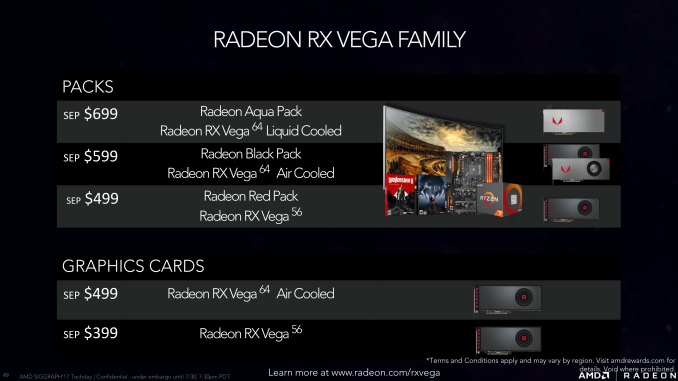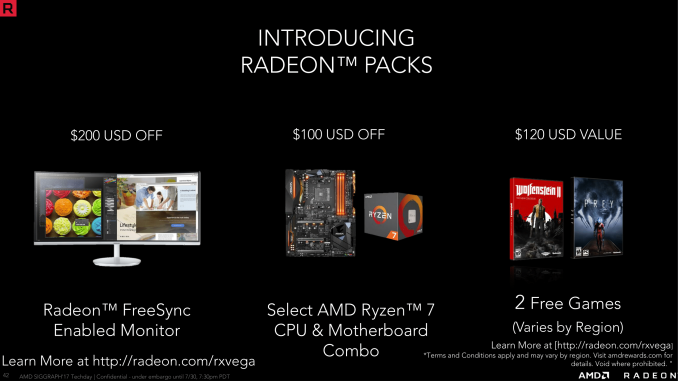The AMD Radeon RX Vega 64 & RX Vega 56 Review: Vega Burning Bright
by Ryan Smith & Nate Oh on August 14, 2017 9:00 AM ESTThe Potential Cloud over Vega: Cryptocurrency Demand
While AMD has a solid game plan in place in terms of products, getting those cards to gamers may be the trickier proposition. For the last few months the company has been selling every last Polaris 10 GPU they can produce, which is not a bad situation to be in for the underdog GPU manufacturer. However those great sales have not come courtesy of gamers, but rather of cryptocurrency miners, who have been riding a wave of high coin values.
As a result, for gamers this has been the summer of waiting. Miner demand has rapidly depleted the video card market, sending prices spiking on those cards that remain. Unfortunately this has come at the cost of gamers, who have been left with few options besides waiting for more cards to become available, or pay sometimes vastly inflated prices for mid-range and enthusiast cards. Worse still, it has reached a point where it’s impacting NVIDIA card pricing and availability as well, so any value-priced GeForce cards are going just as quickly.
Consequently, for the Vega launch AMD has significant concerns about whether they’ll be able to keep cards from getting scooped up by miners. The problem is one of pure economics – video cards are downright cheap for the amount of silicon they come with – which limits AMD’s options here. If Vega cards are good at mining, then miners will buy them until the market reaches a new equilibrium, one where everyone pays more. AMD has a counterplan in place with their Radeon Pack bundles (more on this in a minute), but ultimately AMD is not in control of Vega demand.
The good news is that as it stands right now, it’s looking like Vega-based cards aren’t going to be especially good at mining, dodging the problem Polaris continues to face. However AMD is also recognizes that the biggest groups engaging in cryptocurrency mining have significant resources to throw into optimizations – including firmware modifications – which means that miners can’t be counted out quite yet. Even if Vega doesn’t perform well with current coins, all it would take is for another Vega-friendly coin to spike in price to start the whole process over again.
Competitive Positioning & Radeon Packs
Moving on, let’s talk about the competitive positioning of these cards and how AMD will be making them available to the public. With the RX Vega series, AMD is taking a direct shot at the heart and soul of NVIDIA’s enthusiast range of video cards, the GeForce GTX 1080 and GTX 1070.
We’ve previously been told to expect the Vega 64 to trade blows with the GTX 1080, and AMD is pricing it accordingly. The bare card will have an official MSRP of $499, which is the same as the official MSRP of the GTX 1080. In practice, the GTX 1080 has been running for around $30 more than that due to the effects of miner demand. So if the Vega 64 launches at $499 and stays at that price, it would undercut the GTX 1080 in price by a small amount.
Meanwhile AMD is a lot more gung-ho on the Vega 56, pricing it aggressively and stating that they expect it to take a solid lead over the GeForce GTX 1070. Complicating matters here significantly is that the GTX 1070 has been particularly popular with miners, and as a result market prices are well off of its official $379 MSRP. MSRP-to-MSRP, Vega 56 versus GTX 1070 is a very interesting fight, but at the GTX 1070’s market prices it’s a different matter. If AMD actually gets the Vega 56 out at $399 and holds it there, they’d have a significant price advantage and decent performance advantage over the GTX 1070, giving them a strong position as the value choice. However with Vega 56 not set to launch for another two weeks, there are a lot of “ifs” in the above statements and we’ll have to wait to see where retail prices actually land.
Throwing one last complication into matters, as part of their efforts to stymie cryptocurrency miners, AMD is offering RX Vega cards both with and without bundles. The latter point is going to be especially important, because these are no ordinary bundles. But if you just want a card – full stop – then AMD will be selling both the Vega 56 and Vega 64 stand-alone. These cards will go for $399 and $499 respectively.
As for AMD’s fancier Vega 64 Limited Edition and Vega 64 Liquid Cooled Edition card, these will not be available on a stand-alone basis at all. If you want these cards, they will only be available as part of a bundle.
However what’s not being said by AMD is how much of the RX Vega launch supply will be allocated to stand-alone cards. For various reasons the bundles are more lucrative to AMD and its partners, and as a result it’s difficult to imagine AMD sending the bulk of the cards to stand-alone configurations, or even a 50-50 split. Instead I expect that the bulk of the cards will go towards the bundles. So while we’re going to have to see what launch day brings next month, I’m not convinced that stand-alone cards will be available in great numbers.
Instead, if you want an RX Vega on launch day, and this is where things take an interesting turn. AMD has offered hardware bundles and game bundles before, but for their latest Radeon family, they have never offered a bundle quite like this.
For what amounts to a $100 premium, AMD is doing a combined software and hardware bundle. AMD calls these the Radeon Packs, and they include bundled games and hardware discounts. In short, if you commit to buying an RX Vega card for $100 more, you get access to AMD’s best cards with additional games and some sizable hardware discounts.
Overall the bundle contains the following items: an RX Vega video card, a $200 discount on Samsung’s CF791 34-inch WQHD Curved Freesync monitor, a $100 discount on a Ryzen 7 + motherboard bundle, and 2 AAA games (for North America this is Wolfenstein II and Prey, coming from AMD’s close partner Bethesda).
Bundle Contents
- AMD Radeon RX Vega Card
- 2 Bundled Games (For US: Wolfenstein II and Prey)
- $200 Discount: Samsung CF791 34-inch Widescreen Freesync Monitor
- $100 Discount: Ryzen 7 + Motherboard Combo
Perhaps the most important aspect of the deal is how the bundles work. Unlike traditional retailer bundles, these AMD bundles require purchasing the Radeon Pack version of the card. If you buy the stand-alone RX Vega cards, then you won’t get the games or qualify for the hardware discounts. And these Radeon Pack SKUs are, in turn, priced $100 over the stand-alone cards.
As for the contents of the bundle, the bundled games are rather straightforward: the bundle simply comes with the games (presumably in voucher form). For the hardware however, the discounts come in the form of an instant rebate on the hardware, not a voucher or other “bankable” form. This means that if you buy a Radeon Pack SKU, you must buy the discounted hardware at the same time to get the discount. You are not required to buy the hardware – instead paying the $100 premium just for the card selection and included games – but the discounts cannot be saved until later. It’s now or never.
All told then, the total cost to take full advantage of a Radeon Pack will not be cheap. The packs themselves are priced at $499 for the Vega 56 pack (Red Pack), $599 for a Vega 64 pack (Black Pack), or $699 for a Vega 64 Liquid Cooled Edition pack (Aqua Pack). Meanwhile, turning to our favorite retailer Newegg, the Samsung CF791 currently retails for $936, a Ryzen 7 1700X is $339, and a good X370 motherboard is $129 (or more). This would bring the total cost, after the $300 in rebates, to $1700.
Update: As of 10am ET, Newegg's entire allocation of Vega 64 cards has sold through. This includes the stand-alone cards and the bundled cards. Indications are that Newegg's stock of cards sold through in under 15 minutes.
| Summer 2017 GPU Pricing Comparison (Crypto-Crazy Edition) | |||||
| AMD | Price | NVIDIA | |||
| Radeon RX Vega 64 | $499 | GeForce GTX 1080 | |||
| $449 | GeForce GTX 1070 | ||||
| Radeon RX Vega 56 | $399 | ||||
| Radeon RX 580 (8GB) | $299 | GeForce GTX 1060 (6GB) | |||












213 Comments
View All Comments
ddriver - Tuesday, August 15, 2017 - link
More like "since nvidia castrates FP64 performance like razy" and "AT sure doesn't want to make nvidia look bad"...Manch - Tuesday, August 15, 2017 - link
and here we go with the shill comments....ZeDestructor - Tuesday, August 15, 2017 - link
AMD would look just as bad given they cut down FP64 just as much on modern cards.zoxo - Monday, August 14, 2017 - link
fp32 works well for MD tasks, there is not much need for double precision atm.mapesdhs - Monday, August 14, 2017 - link
If you need FP64, just stuff in some cheap, used GTX 580s. Or hunt for an original Titan or two. Actually, a Quadro 6000 is also a pretty decent buy for FP64.abrowne1993 - Monday, August 14, 2017 - link
I imagine a lot of people are very happy to have something when the embargo lifts even if it's not complete yet.vanilla_gorilla - Monday, August 14, 2017 - link
Thank you for not making us wait for the whole thing, that's awesome.Xajel - Monday, August 14, 2017 - link
Take your time with it...On a Side note, I would love to see a revisit on the the current status of GPU's and iGPU's (&CPU's & APU) on the Media Centric usage scenario (like the old HTPC GPU roundup), but with increased modern media usage scenarios like for example streaming, 4K, x265, HEVC, Plex, transcoding, encoding, etc...
romrunning - Monday, August 14, 2017 - link
6th para - "seceded" should be "ceded" - AMD basically yielded the high-market to Nvidia, not "withdraw" to Nvidia. :)Dr.Neale - Monday, August 14, 2017 - link
Hear, hear!Indeed, this needed to be noted.
Thank you for doing so!